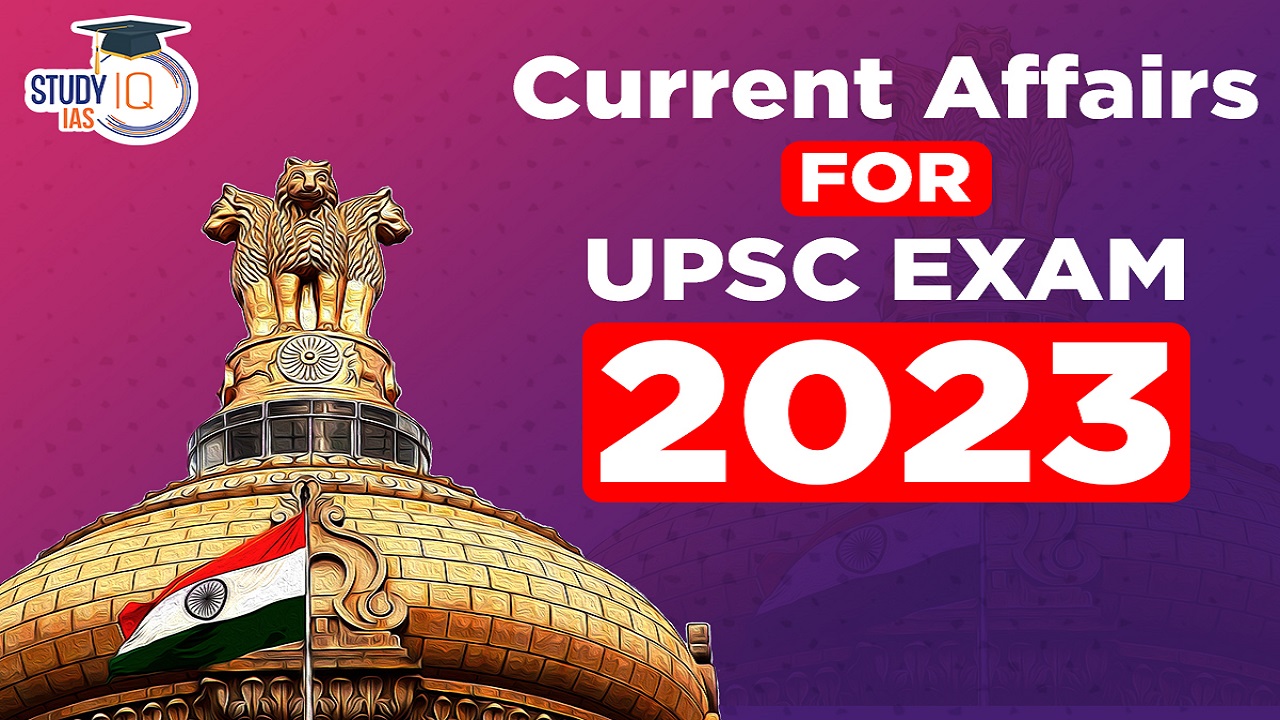Current Affairs 13th May 2023 for UPSC Prelims Exam
LIBOR
Context: Reserve Bank of India (RBI) has advised banks and other RBI-regulated entities to ensure complete transition away from the London Interbank Offered Rate (LIBOR) from July 1.
About London Inter-bank Offered Rate (LIBOR)
- The London Interbank Offered Rate (LIBOR) is a benchmark interest rate used by major international banks in the international interbank market to lend to one another for short-term loans.
- The rate is calculated and published every day by the Intercontinental Exchange (ICE), U.K.
- Intercontinental Exchange polls major worldwide banks every day to see how much they would charge for short-term loans.
- The average is then calculated using these numbers.
- It is based on five currencies: The US dollar, Euro, British Pound, Japanese Yen, and Swiss Franc, and it has seven possible maturity periods.
- Each business day, 35 separate LIBOR rates are calculated and presented due to the combination of 5 currencies and 7 maturities.
- The three-month US dollar rate, often known as the current LIBOR rate, is the most commonly cited rate.
- Traditionally, the interest rates for most Indian corporates availing of external commercial borrowings (ECBs) and foreign currency lending are benchmarked to the three-month or six-month Libor rate.
Potential Replacement
- SOFR (Secured Overnight Financing Rate) will be accepted as the new benchmark rate.
- SOFR is linked to US treasury market transactions.
Current Affairs 12th May 2023 for UPSC Prelims Exam
Electronic Voting Machine (EVM)
Context: The Election Commission of India (ECI) denies Congress Party’s claim on EVMs being brought from South Africa.
About Electronic Voting Machine (EVM)
- An electronic voting machine (EVM) is a portable instrument for the purpose of conducting elections to the parliament, legislature and local bodies like panchayats and municipalities.
- EVM is a microcontroller-based instrument designed to modernize the election procedure and there is no scope for invalid votes and total secrecy of voting data is maintained and it also facilitates quick and accurate counting.
- It is a reliable system to conduct elections where one person has to be elected out of many candidates.
- The EVM is designed for a single post and a single vote.
- Through an EVM, a voter can cast their vote for the candidate of their choice or choose the NOTA option.
- In 1989, the Election Commission (EC) developed India’s indigenous Electronic Voting Machines (EVMs) in alliance with two central government undertakings – the Electronics Corporation of India (ECIL) and Bharat Electronics Limited (BEL).
- EVMs were used for the first time in the Goa State Assembly elections of 1999.
- EVMs are produced indigenously by 2 PSUs viz. Bharat Electronics Ltd., Bengaluru and Electronics Corporation of India Ltd., Hyderabad.
Working Module of EVM
- An EVM consists of a control unit and a balloting unit connected together by a five-metre cable.
- The control unit belongs to a polling officer while the balloting unit is kept in a compartment to cast votes.
- EVMs can even be used in areas with no electricity, as they can be operated on alkaline batteries.
- The balloting unit presents the voter with blue buttons horizontally labelled with corresponding party symbols and candidate names.
- The Control Unit, on the contrary, provides the officer-in-charge with a ‘Ballot’ marked button to proceed to the next voter, instead of issuing a ballot paper to them.

Mitochondrial Donation Treatment
Context: Recently, a baby has been born in the UK using a technique called mitochondrial donation treatment (MDT) (popularly called ‘Three Parents Baby’).
- Baby was developed through a process called mitochondrial donation treatment (MDT), which involves taking the nucleus from one of the mother’s eggs, containing her DNA, and implanting it into a donor egg that had its nucleus removed but retained the donor’s healthy mitochondrial DNA.
About Mitochondria
- Mitochondria are basically the powerhouses of the cells, and they generate the energy, thus responsible for cell function in the human body.
- Certain defects might occur impacting the way the mitochondria produces energy for the cells (Specially in the ‘energy-hungry’ tissues of the brain, nerves, muscles, kidneys, heart, liver), and thereby impacting cell function.
- The diseases that arise out of such mitochondrial mutations are called mitochondrial diseases.
- When the mitochondria are impaired and do not produce sufficient energy, that affects how the organs function, leading to a broad assortment of symptoms across the body, including brain damage, organ failure and muscle wastage.
- Mitochondrial diseases are only passed on by the mother.
- Some estimates put the incidence of mitochondrial diseases as one in 5000 people.

About Mitochondrial Donation Treatment (MDT)
- As part of the treatment, eggs or embryos are created using nuclear genetic material and healthy donated mitochondria.
- The eggs are then combined with mitochondria from the donor’s egg and fertilized with sperm to create embryos.
- This ensures that the baby has DNA from both the mother and the father and a tiny set from the donor.
- While most of the DNA came from the parents of the baby, a tiny fraction of 0.1 per cent came from a third donor who is a woman.
Global Cases
- Britain is not the first country to see children born through MDT.
- In 2016, a child was born in Mexico through the procedure, and since then, there have been several successful cases in countries like the US and Ukraine.
Sahyadri Tiger Reserve (STR)
Context: Assessment of tiger reserves (TRs) in the country, conducted in 2022, has given a ‘Very Good’ grade to the Sahyadri Tiger Reserve (STR).
About Sahyadri Tiger Reserve (STR)
- The Sahyadri Tiger Reserve is located in the Sahyadri Ranges of Western Ghats in Maharashtra.
- These ranges form a common boundary between Maharashtra, Karnataka and Goa, and comprise of rich evergreen, semi-evergreen and moist deciduous forests.
- The region of the Sahyadri Tiger Reserve includes the area around the Koyna Dam, Warna River and many other small rivers and streams originating from the Western Ghats and flowing to the east.
- It is the first Tiger Reserve of Western Maharashtra and the fourth Tiger Reserve of the State spreading over two Protected Areas of Koyana Sanctuary (KWLS) and Chandoli National Park (CNP).
- The habitat of Sahyadri is composed of woodlands, grasslands and plateau, the latter locally referred to as “Sadaa”, which are lateritic in nature with considerable habitat value.
- It is home to the endangered species of top carnivores such as Tiger, Wild dog, and Leopard. The herbivores include Gaur, Sambar, Four Horned Antelope, Mouse Deer and Giant Squirrel
- It also supports Hornbills, and many other endemic Birds.
- The breeding grounds of the Indian River Tern are found in Chandoli National Park and Koyana Sanctuary area. There are 58 varieties of snakes. The Blue finned Mahasheer fish is present in the Koyana waters.
- History: The history of the area dates back to the Maratha Empire and many forts built or captured by the first Maratha Emperor Chhatrapati Shivaji can be found here.
- The legendary temple from where Shivaji received the Bhavani Sword from divine providence is also said to be among the many ruins of this region.

Carbon Dating
Context: The Allahabad High Court has called for carbon dating of a “Shivling” that was found at the Gyanvapi mosque complex in Varanasi.
What is Carbon Dating?
- Carbon dating is a widely used method to establish the age of once living organic materials. The dating method makes use of Carbon-14 (C-14), an isotope of carbon.
- Principle behind the technique:
- All living things have carbon in them in various forms. There are two type of carbon present in the atmosphere, C-12 and C-14.
- C-14 is radioactive and undergoes decay. Plants and animals acquire C-12 and C-14 in roughly the same proportion as is available in the atmosphere.
- After the death of the plant or animal, their interaction with the atmosphere stops. While C-12 is stable, the C-14 reduces to one half of itself in about 5,730 years, which is known as its ‘half-life’.
- The change in ratio of C-12 to C-14 in the remains of a plant or animal can be measured after it died and can be used to calculate the approximate time when the organism died.

- Applications of Carbon Dating:
- It has proved to be a versatile technique of dating fossils and archaeological specimens from 500 to 50,000 years old.
- The method is widely used by geologists, anthropologists, archaeologists, and investigators in related fields.
- Drawbacks of the technique:
- It cannot be used to determine the age of non-living things like rocks.
- The age of things more than 40,000-50,000 years old cannot be determined because after 8-10 cycles of half-lives, the amount of C-14 becomes almost undetectable.
Other methods of Dating:
- Potassium-argon dating: Potassium’s radioactive isotope decays into argon and their ratios can give a clue about the age of rocks.
- Uranium-thorium-lead dating: Several radioactive isotopes of uranium and thorium decays into the stable lead atom. The ratios of these elements present in the material can be used to estimates age.
- Cosmogenic nuclide dating (CRN): It is regularly applied to study the age of ice cores in Polar Regions.
Cape Town Convention
Context: The Aviation Working Group (AWG), a UK-based aviation leasing watchdog has put India on a watch list with a negative outlook saying it failed to comply with the Cape Town Convention and its Aircraft Protocol after airline Go First was granted bankruptcy protection.
About the Cape Town Convention (CTC)
- The Cape Town Convention on International Interests in Mobile Equipment, commonly known as the Cape Town Convention (CTC), is an international treaty that aims to facilitate financing and leasing of movable assets, particularly in the aviation and aircraft industry.
- The convention was adopted at a diplomatic conference held in Cape Town, South Africa, in 2001 and entered into force on April 1, 2004.
- The Convention was adopted under the joint auspices of ICAO (International Civil Aviation Organization) and UNIDROIT (International Institute for the Unification of Private Law).
- ICAO is a specialized agency of the United Nations that coordinates the principles and techniques of international air navigation and fosters the planning and development of international air transport to ensure safe and orderly growth. (HQ: Montreal, Canada)
- UNIDROIT is an intergovernmental organization whose objective is to harmonize international private law across countries through uniform rules, international conventions, and the production of model laws, sets of principles, guides and guidelines. (HQ: Rome, Italy)
- Many countries have ratified the Convention to promote investment in their aviation sectors and provide greater legal certainty for creditors and lessors (India ratified the convention in 2008).
- Key features of the convention:
- The CTC establishes a framework specific to the financing and leasing of high-value mobile assets, including aircraft, aircraft engines, and helicopters.
- It provides a standardized legal regime for the creation, registration, and enforcement of security interests in these assets.
- The CTC sets out detailed provisions regarding default remedies and the repossession of assets in the event of default or insolvency.
- It establishes clear rules for lessors and secured creditors to repossess and sell the assets, ensuring a predictable legal framework for their enforcement rights.
About the Aviation Working Group (AWG)
- It is a not-for-profit legal entity comprised of major aviation manufacturers, leasing companies and financial institutions that contributes to the development of policies, laws and regulations that facilitate advanced international aviation financing and leasing.


 TNPSC Group 4 Admit Card 2025 Out at tnp...
TNPSC Group 4 Admit Card 2025 Out at tnp...
 Species Added to India's Flora and Fauna...
Species Added to India's Flora and Fauna...
 Daily Quiz 02 July 2025
Daily Quiz 02 July 2025





















